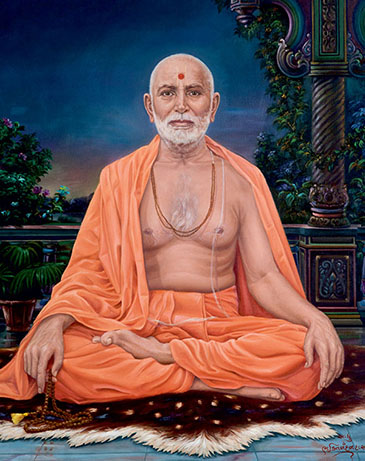Shastriji Maharaj (31 January 1865 – 10 May 1951), born Dungar Patel and ordained Shastri Yagnapurushdas, was a sadhu of the Swaminarayan Sampraday and was later accepted as the third spiritual successor of Swaminarayan and founder of the BAPS Swaminarayan Sanstha. Born in a family of farmers in central Gujarat, India, he became a sadhu within the Vadtal diocese of the Swaminarayan Sampraday at the age of 17 where he was given the name Yagnapurushdas Swami. The prefix Shastri was later added in recognition of his eminent scholarship in Sanskrit and the Hindu scriptures. He established BAPS after a doctrinal split from the Vadtal diocese of the Swaminarayan Sampradaya.
Shastriji Maharaj is credited with establishing BAPS on 5 June 1907 CE in Bochasan, Gujarat to propagate the Akshar-Purushottam Upasana (philosophy), which, he explained, had been revealed by Swaminarayan. A staunch proponent of this philosophy, he consecrated the sacred images of Swaminarayan (as a manifestation of Purushottam) and Gunatitanand Swami (as a manifestation of Akshar) in the central shrines of major mandirs in the towns of Bochasan, Sarangpur, Atladra, Gondal, and Gadhada in Gujarat, India.
In the early 1950s, having successfully laid the foundations of BAPS, he appointed Pramukh Swami Maharaj as its administrative head to serve under Yogiji Maharaj, whom he revealed as the 4th spiritual successor to Swaminarayan.
Dungar Patel was born on 31 January 1865 in Mahelav into a deeply religious family. His parents, Dhoribhai and Hetba Patel had 4 other children, Mathurbhai, Laldas, Sonaba and Raliatben, of which Dungar was the youngest. Various anecdotes of Shastriji Maharaj’s childhood demonstrate his early spiritual inclination and intellectual prowess. These include his preference for building mandirs out of sand while other children his age played with toys, his observance of religious fasts from a young age and an impromptu recital of the Mahabharata to the entire village. He first received formal education at the village school under the tutelage of Gangaram Mehta of Alindra. In addition to this, Dungar often interacted with sadhus at the Swaminarayan temple in Mahelav and began studying the Bhagavad Gita and other Hindu scriptures under them. This initial education would be further enhanced under Vignananand Swami an illustrious and eminent sadhu who had been initiated by Swaminarayan.
Dungar initially came into contact with Vignananand Swami during the Chaitra festival in 1881 whereupon the Swami impressed Dungar with his spirituality and renunciation of material objects. Having found a suitable senior sadhu to learn under in Vignananand Swami, Dungar decided to become a sadhu himself and live a life of devotional service and asceticism. During this period, Dungar immersed himself in devotional service and scriptural study. His meticulousness and dedication to his duties caught the attention of Acharya Viharilalji Maharaj (the Acharya of the Vadtal diocese) and Gordhanbhai Kothari (Chief Administrator of the Vadtal diocese), both of whom shared a love and admiration for Dungar that would persist despite the doctrinal differences that would later emerge.
Dungar continued to excel in his studies of the Sarasvat and other Sanskrit texts. He was also very adept in temple management. Taking note of this, Vignananand Swami entrusted him, while still in his teens, with the administrative duties of Surat mandir with a view of initiating him as a sadhu at the earliest opportunity.
Shastriji Maharaj’s most enduring legacy is the founding of BAPS. His unwavering belief in the Akshar Purushottam upasana was the chief reason for his departure from Vadtal and is an indication of his conviction towards this philosophy. Under his leadership, there was a “focused emphasis on the building of shikharbaddha mandirs as a means of conveying Swaminarayan upasana.”
His administrative and organizational abilities were apparent during his work as the de facto Kothari of Surat mandir and Kim observes that, “Shastri Maharaj and his small group of followers are revered by satsangis for their resourcefulness and indefatigable efforts to build temples.” Further insights into his character reveal that “Shastri Maharaj expected his followers to demonstrate, by their thoughts and actions, their commitment to a peaceful devotional tradition, one that idealizes gestures that directly serve Bhagwan and Guru.” Shastriji Maharaj played an integral part in laying the foundation for the establishment of BAPS overseas through discourses and communication with devotees in Africa. In one such letter, Shastriji Maharaj emphasized his adherence to truth by stating a verse in the Gita-“Nasatyat Param Papam”, Untruth is the greatest sin-as one of his important maxims and gave a succinct reasoning for his belief in the Akshar-Purushottam Upasana.
As a charismatic and determined leader, he “overcame obstructions to land acquisition, temple construction, and the dissemination of his teachings and acquired a loyal and growing group of devotees, admirers, and political supporters, many of whom were formerly associated with the original Vadtal Swaminarayan Sampradaya.” Having laid the foundations of BAPS, he secured the spiritual and administrative future of the organization through the appointments of Yogiji Maharaj and Pramukh Swami Maharaj, respectively.
(Ref : https://en.wikipedia.org/wiki/Shastriji_Maharaj & http://www.baps.org/)
